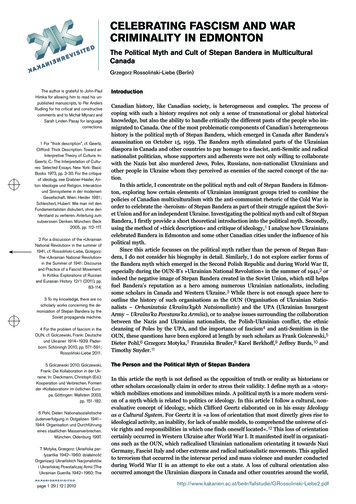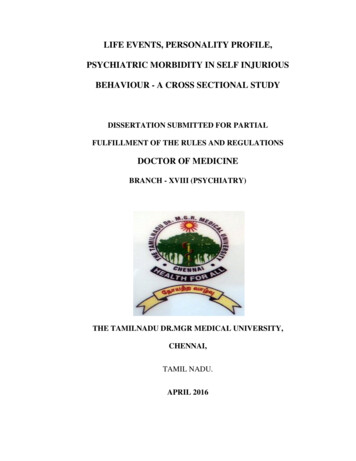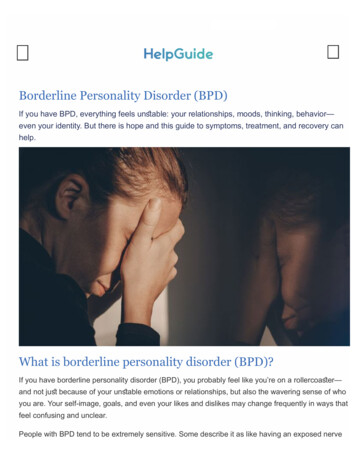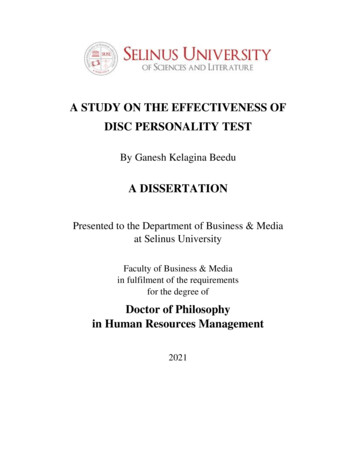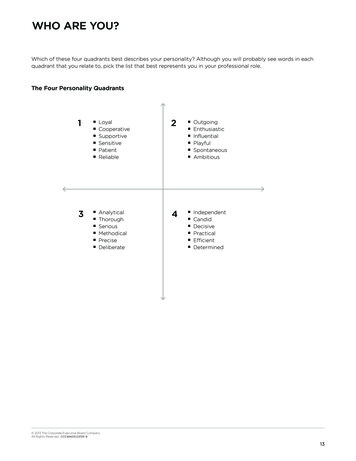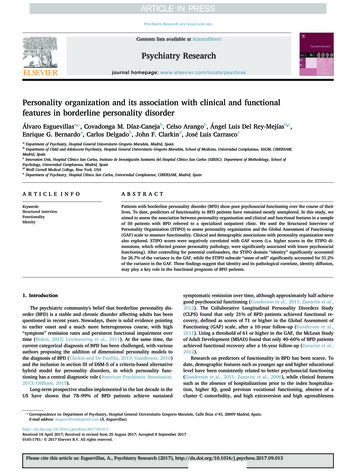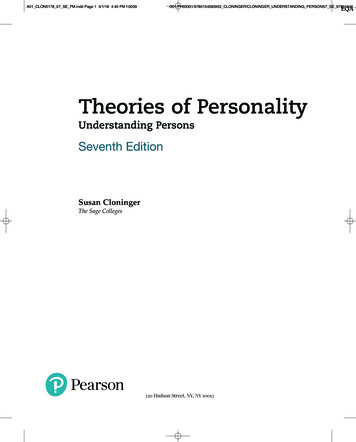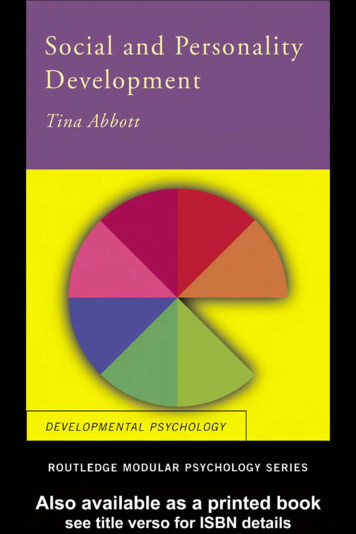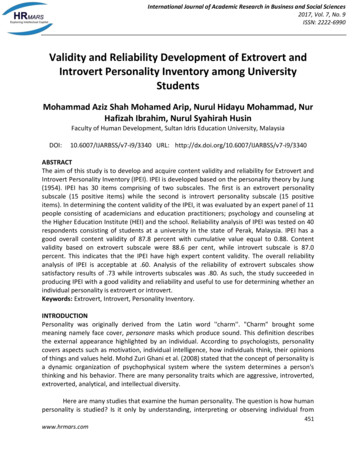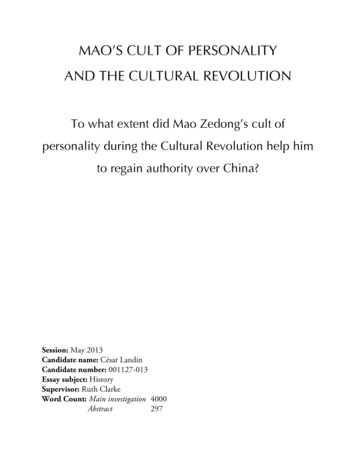
Transcription
MAO’S CULT OF PERSONALITYAND THE CULTURAL REVOLUTIONTo what extent did Mao Zedong’s cult ofpersonality during the Cultural Revolution help himto regain authority over China?Session: May 2013Candidate name: César LandínCandidate number: 001127-013Essay subject: HistorySupervisor: Ruth ClarkeWord Count: Main investigation 4000Abstract297
ABSTRACTThis essay investigates the question “to what extent did Mao Zedong’s cult of personality during theCultural Revolution help him to regain authority over China?” In order to answer this question, thebackground of the Cultural Revolution was researched first. Then, historiographical analysis wasused to find whether Mao used the Cultural Revolution to regain power using a wide range ofprimary and secondary sources, including first-hand accounts and academic research. Official sourceswere contrasted to historians with opposing views to come to a conclusion. The third section of theinvestigation explored the various methods Mao used to regain authority, beginning with his Cult ofPersonality and then comparing this to the purging of Communist Party officials and the country.The evidence found in the first two sections of this investigation led me to conclude that theCultural Revolution was used by Mao Zedong to regain power after being shamed after the GreatLeap Forward and ceding some of his authority to his comrades Liu Shaoqi and Deng Xiaoping.Regardless of the depth of the research, this conclusion is not completely certain, as there is a lack ofunbiased official primary sources as the Chinese government discourages the research of the CulturalRevolution. The investigation is therefore restricted to possibly biased primary sources, subjectiveofficial documents, and limited research by historians.Finally, it was concluded that the purging of the Communist Party and the country was the mainreason why Mao managed to regain authority during the Cultural Revolution. Even though Maoobtained public support with his cult of personality, this did not help him to reclaim his power andin the end it was the elimination of his enemies through purges conducted by the Red Guards thatallowed Mao to make his rule unchallengeable once again.
TABLE OF CONTENTSINTRODUCTION . 7INVESTIGATION . 9THE ELIMINATION OF THE OPPOSITION AND MAO’S LOSS OF POWER . 9SHORT-TERM CAUSES AND AIMS OF THE CULTURAL REVOLUTION . 11MAO’S CULT OF PERSONALITY AND RETURN TO POWER . 14CONCLUSION . 18REFERENCE LIST . 19
INTRODUCTIONMao Zedong was the leader, spokesperson and symbol of the Communist revolution in China. Afterachieving victory against the Nationalists, he founded the People’s Republic of China and became itschairman and leader. When Mao came to power in 1949, immediate land reforms brought atemporary end to millennia of unproductive farming methods, poor harvests and famines. But, hisrevolutionary spirit did not end there, and thus Mao undertook the greatest economical reform sinceStalin’s collectivisation of agriculture. The Great Leap Forward started as a life-changing movement,as the sole event that would bring China onto the world stage and get peasants the life they deserved.It proved to be an utter failure, killing millions and leaving the countryside devastated. As a result ofthis, his authority within the communist party diminished significantly, and Mao was soon detachedfrom leading the country he liberated. Seeing his authority within the party lessen, the great leadersought to regain his power by purging not only the party, but the whole country and establishing apersonality cult to make his rule unchallengeable.Karl Marx, the creator of the ideology on which communism is based, first used the term ‘cult of theindividual’ when criticising his own public image in a letter to a fellow politician (Marx, 1908). Thecult of personality that we know nowadays can be described as the glorious, heroic and sacred publicimage of an individual created through the use of mass media and propaganda. Even though it wentagainst the basic principles of Marxism, Lenin, Stalin and Mao, amongst other leaders, created a cultof personality for themselves to legitimise their rule and gain absolute control of the masses. Theirmanipulation of society allowed for terrible crimes to be committed under the protection of theircults.In this essay, the question ‘To what extent did Mao Zedong’s cult of personality during the CulturalRevolution helped him to regain authority over China?’ will be analysed. The Cultural Revolution isa significant historical event because it completely changed the culture and society of the countryfrom its core in only a few of years of armed conflict and a decade of political struggle. It is worthyof investigation since it is Mao’s most important legacy and still affects China. It completely erasedprevious societal norms and traditions, led to the creation of new customs, and changed the values ofthe people -the core of Chinese society.7
There are numerous views on the causes of the Cultural Revolution, Mao’s aims -particularly onwhether he wanted to regain authority-, its duration and the responsibility for the launch of thismassive campaign. Most historians agree that Mao started it, but they provide different explanationsfor this. Jung Chang (1992) writes in Wild Swans that the Cultural Revolution was “a bloody purgeto increase Mao’s personal power”, a view that is partly shared by Zhisui Li (1994) who states thatthe main aim was to “destroy” Liu Shaoqi and Deng Xiaoping. Michael Lynch (2004) supports theview that the principal objective during the Cultural Revolution was to cleanse the party, yet hestates that it was pushed farther than Mao had intended. Some even suggest that it was truly meantto help Mao achieve his revolutionary ideals, as Roderick MacFarquhar (2008) proposes, writing thatthe true purpose of the movement was to reduce corruption and bureaucracy in the CommunistParty.It is without doubt that the Cultural Revolution completely transformed Chinese culture and wasone of the greatest socio-political movements that the world has seen. Mao’s cult of personalityearned him adoration and worship from the Chinese people, but was not as crucial as the purging ofparty officials in his attempt to regain control over the Communist Party and the country as a whole.8
THE ELIMINATION OF THE OPPOSITION AND MAO’S LOSS OF POWERThe techniques Mao used to regain power during the Cultural Revolution were first used during theKorean War, and were perfected during the Three and Five-Anti campaigns. A mere year afterwinning the civil war against the Nationalists, the Chinese government launched a propagandacampaign to raise money and increase popular support for the war. People were mobilised to dofundraising events for the soldiers, and big posters depicting the army’s heroic acts were used to raisethe morale at home. These same techniques to garner support for the Korean War were used duringthe “Three Anti’s” and “Five Anti’s” campaigns near the end of1951 to eliminate corruption, bureaucracy and fraud amongindustrialists and the government itself. In reality Mao targeted hispolitical opponents with the purpose of consolidating his power.The Hundred Flowers Campaign and the Anti-Rightist campaignperfected the techniques used previously to purge the country of socalled criminals, but differed from previous campaigns for Mao nowharnessed China’s ‘people power’ to eliminate his enemies. Whenthe government collectivised agriculture in 1953, many intellectualsbegan to denounce the government’s faulty economic policies(Chang, 1992). Increasingly worried about intellectuals and the newelite, Mao started the Hundred Flowers Campaign in 1956 and‘Start the movement to increaseproduction and practise thrift, withfoodstuffs and steel at the centre,with great force!’ (ChongqingPeople's Publishing House, 1960)encouraged people to constructively criticise the government in aspeech. But, the campaign quickly became larger than Mao wanted and criticisms turned moreaggressive, so it was halted and replaced by its opposite: the Anti-Rightist Campaign, in which allrightists intellectuals were to be denounced. This campaign demonstrated the same characteristics asthe Cultural Revolution: personal scores were settled, intellectuals were punished, and afterwardspeople were afraid to speak up against the government. The Hundred Flowers Campaignencouraged Mao to purge the country of the opposition and was a preamble of what was to comelater on.9
The Great Leap Forward was Mao’s attempt to transform China into a world superpower, and itsfailure would lessen the power Mao had on the communist party and China and motivate him toplot to regain authority with the Cultural Revolution. When July 1955 came, Mao called for aspeeding up of the collectivisation of agriculture, and nationalised all industry and commerce. Thiswas the start of the Great Leap Forward. People were encouraged to produce steel in small-scaleoperations by collecting scrap steel and melting it together in backyard furnaces; this wouldsupposedly make China a superpower in 15 years. This massive campaign was accompanied by theusual propaganda drive, with uplifting music and banners encouraging people to make steel. Insteadof producing industrial-grade steel, inexperienced peasants ended up with useless 'pig' steel. Whenharvest time came in 1959, there were few people in the fields, and farming experiments, combinedwith corruption in the reporting of figures to the government, led to the worst famine in history.The famine hit the country so badly that a special conference was called at Lushan, during whichDefence Secretary Marshal Peng Dehuai expressed his doubts of the Great Leap Forward in a letterto Mao. Instead of listening to his recommendations, Mao replaced Peng with Marshall Lin Biaoand kept the Great Leap Forward going. From 1958 until 1962, tens of millions of people died allacross China, until pressure from Liu Shaoqi and Deng Xiaoping, two of the top political leaders inChina, made Mao take on a path of stability and reform. Mao then lost the title of Chairman of thePeople’s Republic of China, ceding it to Liu Shaoqi.1 He retired from one of his top leadership postswith his reputation damaged while maintaining an enormous following over China- but his mistakeshad diminished his authority within the Communist Party. The Great Leap Forward ultimately ledMao to plot to regain authority through the Cultural Revolution.1Mao was the ‘Paramount Leader’ of China from his rise to power in 1949 until his death in 1976. The ParamountLeader is usually the one who holds the highest government posts, though this has varied throughout the years.However, his authority was sometimes symbolic, and diminished significantly after the Great Leap Forward, when hewas forced to do a ‘self-criticism’ and lost his title of Chairman of the People’s Republic of China.10
SHORT-TERM CAUSES AND AIMS OF THE CULTURAL REVOLUTIONThe Cultural Revolution can trace its immediate causes to a series of reactions caused by aprovocative play, particularly an article written by Mao calling for the elimination of his enemies andoutlining his public aims for the Cultural Revolution. The play ‘The Dismissal of Hai Rui fromOffice’ by Wu Han was first published in 1959, and narrated the story of an honest official who wasdismissed after exposing corruption. Mao initially ignored it, but he later discovered it relatedstrongly to Peng Dehuai’s dismissal when he read an article written by a newspaper editor inShanghai called Peng Zhen. Mao retaliated by forcing Peng Zhen to publicly denounce Wu Han.On May 16th 1966 the Politburo released a report called ‘The May 16th circular’ in which aCultural Revolution Group was created. This document formally marks the beginning of theCultural Revolution and explains Mao’s key aims -or at least those made public: to rid theCommunist party from ‘capitalist roaders’, criticize and reactionary bourgeois academics, andtransform culture to consolidate the socialist system (Roberts, 1996). As the public began to findout, protests lighted up at universities against 'revisionists' and were exacerbated by Mao’s support tothe rioters. Work teams led by Liu Shaoqi were sent to the major universities to try and calm downstudents, but were stopped by Mao himself- he wanted the students to continue. Mao used thisincident to appoint Lin Biao as the second in power in the Politburo, substituting Liu. This way,Chairman Mao set up an apparatus of control independent of the Communist Party that wouldallow him to create a cult of personality, and regain control over China.Mao’s motives for the Cultural Revolution and his responsibility for the mass movement are subjectsof intense historical debate. Though many historians support the theory that Mao’s key motive forinitiation the Cultural Revolution was to regain the power he had lost years before in the aftermathof the Great Leap Forward, there are some who support the official Communist Party view: thatMao intended for the Cultural Revolution to reform the Communist Party for the good of thepeople. This view is held by the Chinese government, and was made public in a document called‘Resolutions on Party History’ in 1981, when thousands of party officials and Chinese historianscollaborated under the command of Deng Xiaoping to create an official explanation for the CulturalRevolution. The ‘Resolution’ did state that the Cultural Revolution was initiated and led by MaoZedong, but it stated that its purpose was to eradicate the representatives of the bourgeois and11
‘counterrevolutionary revisionists’ that had sneaked into the party by mobilizing the masses(MacFarquhar & Schoenhals, 2008). Even though this document acknowledges some of Mao’smistakes during the Cultural Revolution, it absolved him of most of his responsibility. RoderickMacFarquhar, Michael Schoenhals and Harry Harding, who have written extensively on China andthe Communist regime, offer a balanced perspective on Mao’s aims and responsibility. The authorsstate that while the responsibility for the Cultural Revolution is solely Mao’s (MacFarquhar, et al.,1993), he sincerely wanted to eliminate increasingcorruption and bureaucracy in the party, butinterpreted them as signs of revisionism and ‘bourgeoiselements’ in the party leadership (MacFarquhar &Schoenhals, 2008). According to this view, Mao had anoble aim in the Cultural Revolution, yet he chose tointerpret decadence in the party as a struggle between‘Forging ahead courageously while following thegreat leader Chairman Mao!’ (Shanghai People'sFine Arts Publishing House, 1969)true revolutionaries and revisionists.However, there are several authors that offer the non-orthodox view of the Cultural Revolution that Mao purged the country of his enemies during theCultural Revolution. Still, these are limited as academic research on the Cultural Revolution hasbeen strongly discouraged by the Chinese government ever since the ‘Resolution’ was published(MacFarquhar & Schoenhals, 2008).2 Michael Lynch, a historian specialized in Far Eastern History,has written a number of books on China and often offers an objective argument. Lynch writes in hisbook ‘Mao’ how Mao's response to Wu Han's play revealed that the Cultural Revolution was not animprovised reaction against ‘counterrevolutionaries’, but that its main purpose was to reassert hisauthority over China and the CCP to preserve himself in power. More importantly, this was apretext for undermining Liu Shaoqi and Deng Xiaoping, leaving the Cultural Revolution as“another stage in the long-running power struggle within the Chinese Communist Party” (Lynch,1998). It is important to remember that the Hai Rui affair had started with the publication of anarticle analysing the original play, which was released four years earlier. If criticism against the partyduring the Hundred Flowers Campaign had angered Mao and led him to put the Anti-Rightist2The Communist Party has tried to keep secret the destructive events that occurred during Mao’s rule. For example,there are very few photos of the famine during the Great Leap Forward (Dikotter, 2010).12
movement in its place, then why didn’t Mao react so aggressively when the play was released in1961? This reveals how Mao’s actions prior to the Cultural Revolution not mere reactions to anewspaper article- the Chairman was only looking for an excuse to implement his plan to regainauthority. Jung Chang makes the strongest statement in favour of this theory. She offers a valuableperspective on the Cultural Revolution, as she was a first-hand witness to the cult of personality andpurges. However, being a primary source also makes her biased, as she uses passionate arguments tocriticize Mao as a leader and as an individual. In her book ‘Wild Swans’, Chang argues how Maoused his cult of personality to regain power. According to Chang (1992), the Cultural Revolutionwas a “bloody purge” to increase Mao's personal power and a way of destroying Liu Shaoqi andDeng Xiaoping. Lastly, another first hand witness of the Cultural Revolution was Zhisui Li, Mao’spersonal physician, who wrote ‘The Private Life Of Chairman Mao’ in 1994. Considering thathistorical evidence for the Cultural Revolution is limited, it is an extremely valuable source as itshows the perspective of a man who knew and was trusted by Mao. According to Zhisui (1994), theultimate targets were the ‘counterrevolutionaries’ Liu and Deng, and the Cultural Revolution was acampaign to destroy them as he despised the ‘capitalist road’ they had taken during the yearsfollowing the Great Leap Forward when they skilfully implemented economic reforms and endedthe famine.The economic policies led by Liu Shaoqi and Deng Xiaoping immediately after the end of the GreatLeap Forward in 1961 set China on the course of recovery, but strayed from the path Mao had setfor the country. The official, Party-approved analysis of the Cultural Revolution concludes that eventhough Mao was responsible for initiating it, he had good objectives that were corrupted by partymembers. Recognized historian Roderick MacFarquhar supports this point, yet Mao’s actions duringthe beginning of the Cultural Revolution show otherwise. Mao mercilessly purged Liu Shaoqi andDeng Xiaoping, long time friends and supporters, during the initial havoc of the ‘Great Purge’. Eventhough Mao Zedong was still the supreme leader of China after the Great Leap Forward andremained idolised throughout the country, he had lost power over the government, and wanted tore-establish his authority over China and the CCP. Hence, Mao Zedong embarked on a decade-longcampaign in which he terrorized his country in his quest to regain authority, while destroying whatwas left of ancient Chinese culture.13
MAO’S CULT OF PERSONALITY AND RETURN TO POWERMao’s cult of personality helped him regain power during the Cultural Revolution, but the purgingof officials and ‘capitalist roaders’ was more important in helping him return to power. Before goingon, it is important to explain first what the Cultural Revolution was. From the beginning, therevolution had little to do with ‘culture’- this wasn’t even mentioned in the May 16th Circular thatstated its aims. When this document was published, a group of students from a university in Beijingformed a group called ‘The Red Guards of Chairman Mao’ and vowed to follow devotedly Mao’sinstructions and to defend the revolution. Mao wrote a public letter offering them his support, andgroups of red guards immediately formed all over the country. Lin Biao, defence minister, gave aseries of speeches to the Red Guards in August 1966, including one in which he called the youngrevolutionaries to ‘smash the four olds’: old ideas, old culture, old customs and old habits; all ofthese were deemed bourgeois and capitalistic. This destruction of cultural relics combined with thehunt for counterrevolutionaries came to be known as the Cultural Revolution.In order to determine to what extent Mao's cult ofpersonality helped him to take over control of China,the methods he used to regain power have to beanalysed. Mao employed a variety of techniques to takehis cult to all of China: he created a sacred image forhimself by handing out "The Little Red Book" tohundreds of millions, instituting strict guidelines forThe sunlight of Mao Zedong Thought illuminatesthe road of the Great Proletarian CulturalRevolution. (Shanghai People's Fine ArtsPublishing House Propaganda Group, 1966)social interaction based on his cult and made peoplerevere him by mass-producing propaganda thatpromoted his glorious acts. On the other side, heincited Red Guards to destroy past culture so he could have complete control over China's cultureand spread fear of his authority by purging rightists and enemies of state.Mao’s cult of personality was successful due to the propaganda drive behind it, and helped himregain public support. Since the foundation of the People’s Republic of China, every time theCommunist Party launched a new policy, it was accompanied with a propaganda campaign to spread14
word of the policy and be able to enforce it. At the centre of these propaganda campaigns was alwaysChairman Mao. When Mao started the Cultural Revolution, he was not in control of the statepropaganda machine. In order take his cult of personality to new heights and regain power, Maoneeded to use alternative venues to circumvent official media -radio, newspapers and magazines.(Schrift, 2001). The main method he used was big-character posters, which were simple whitecanvases with black revolutionary slogans. These were used by Mao to convey his political messagesand helped expand his cult. Another method used was the use of Mao badges, which were powerful,accessible and portable signs of devotion (Schrift, 2001). Thanks to this, Mao took his cult to thepoorest areas of China, raising public support for his cause and sending a clear message to hisadversaries- that he was still in power.Another way Mao developed his Cult of Personality was through the book Quotations fromChairman Mao Zedong, otherwise known as 'The Little Red Book'. This book was the product ofan intense propaganda campaign started by Lin Biao years before the Cultural Revolution began.The Little Red Book, initially published in 1964 for the army, helped indoctrinate the populationand gave the Red Guards a guideline for their activities during the Cultural Revolution. Tightlylinked to this were the daily rituals that were revolved around Mao's image and became a symbol ofhis influence on the country. By 1968, only a year and a half after the start of the CulturalRevolution, the ritualization of Mao's image had reached its height with “grotesque” forms ofworshipping, as Jung Chang (1992) describes. Rituals that had previously started in the PLA weremade public through two key propaganda campaigns: the 'Three Loyalties' and the 'Four BoundlessLoves', which instructed people on what their thoughts should be focused on. These werecomplemented by daily rituals such as 'asking for instructions in the morning and reporting back inthe evening', in which people would ask the Great Helmsman for guidance and then report back ontheir progress under the watchful eye of Mao's portrait (MacFarquhar, 2008). Mao’s god-like imagewas also reinforced by his public appearances, which were not often and were usually in the form ofspeeches to millions of young ‘revolutionaries’. An example of this was when Mao had a verypublicized swim in the Yangtze River in 16 July 1966, a month after the start of the CulturalRevolution. This was very symbolic as it showed the people that Mao was still in good health, and italso sent the message to his enemies that he still had the will to fight (Chang, 2005). Having the15
widespread support of the population allowed Mao to purge his enemies without any oppositionfrom the public and regain power by the end of the Cultural Revolution.Although Mao’s cult of personality allowed himto rise to power without any public opposition, hecould not have conquered the Party withoutdestroying culture, and purging the party and thecountry with the help of the Red Guards. LinBiao instructed millions of Red Guards to destroyold China in a massive rally in 1966. This was inline with Mao's idea of replacing China's culturewith Marxist values and traditions. China lost‘Warriors love reading Chairman Mao's books most.’(People's Liberation Army Daily Agency CollectiveWork, 1966)most of its cultural relics during the time, as onlyhistorical monuments of major importance such as the Forbidden City were protected. Goingagainst the ‘four olds’ served another objective: to terrify Mao’s opponents, the ‘bourgeois’ and‘capitalists’ and ‘reactionaries’ who identified with old traditions. Hence Red Guards often struggledagainst those who owned traditional art pieces. This purge of ‘bourgeois’ influence paled incomparison to the purging of normal citizens and party officials.During the Cultural Revolution Mao never relied on a secret police to silence his opponents.Instead, he relied on the Red Guards to take charge of the punishment, making the mechanismsubjective but extremely effective (Chang, 1992). Violent ‘struggle sessions’ were held against thoseconsidered counterrevolutionaries. Red Guards forced confessions by torturing the accused, and wereeven responsible for leaving Deng Xiaoping’s son paralysed after a particularly violent strugglesession against him. This proved to be Mao’s most effective method to regain power, as it could beused on peasants as well as on Politburo members. Liu Shaoqi and Deng Xiaoping had to attend‘denunciation meetings’, where they would be accused of their crimes and would evolve into strugglesessions. Mao managed to purge them through a combination of both. After encouraging the massesto speak out against ‘revisionist’ Liu, Liu was dismissed from all his posts in the CCP. Sick withdiabetes, his health had been deteriorating for months, and when he was sent to a safe house outsideBeijing in 1969, he was denied his medications and died neglected. Deng, following a series of16
denunciations and struggle sessions, was also dismissed from all posts and forced to write aconfession, and was exiled to a tractor repair shop in a rural province (MacFarquhar, 2008). Thepurging of opponents proved to be the main way Mao regained authority during the CulturalRevolution, but his death cut short his dream of becoming China’s supreme leader once again.17
CONCLUSIONThis investigation sought to find to what extent Mao Zedong’s cult of personality during theCultural Revolution helped him to regain authority over China. This question makes theassumption that Mao’s main aim during the Cultural Revolution was to regain authority, so thisinvestigation focused first on finding what were Mao’s true aims during this movement. Severalperspectives of the topic were analysed in order to determine whether this campaign was a genuineattempt at reducing bureaucracy and corruption in the government or was a purge to destroy Mao’senemies. The evidence presented, which dates back to the early years of the People’s Republic ofChina, and historical debate has led me to conclude that the Cultural Revolution was a plannedstrike of Mao against his enemies in order to regain power.Nevertheless, this is an uncertain conclusion due to the incongruence between the government’sofficial stance and research by historians and primary evidence. This is accentuated by theweaknesses of the source material available, for research on the Cultural Revolution remains taboo inChina and is discouraged by the government, so foreign authors do not have full access to historicalarchives and rely on interviews and official accounts of the subject.If it can be asserted that Mao used the Cultural Revolution to regain power, then it can beconcluded that purging the Communist Party was to a great extent the reason why Mao managed toregain the power he had lost during the Great Leap Forward. The evidence demonstrates that whileMao established a personality cult and successfully garnered public support for the CulturalRevolution, it did not help Mao directly in eliminating his enemies to return to power. Yet it ispossible that the truth about Mao’s aims shall never be known, for as Deng Xiaoping stated in 1980:“Discrediting Comrade Mao Zedong would mean discrediting our Party and state”.18
REFERENCE LISTChang, J. (1992). Wild Swans: Three Daughters of China. London: Harper Collins.Chang, J. (2005). Mao: The Unknown Story. London: Random House.Chongqing People's Publishing House. (Designer). (1960). Start the movement to increase productionand practise thrift, with foodstuffs and steel at the centre, with great force! [Print Graphic].Retrieved from: tter, F. (2010, September 26). Greeting Misery With Violence. Retrieved from /09/26/mao-s-great-famine.htmlDikötter, F. (2010). Mao's Great Famine. London: Bloomsbury.Fenby, J. (2008). Modern China. New York: HarperCollins.Li, Z. (1994). The Private Life Of Chairman Mao. London: Arrow Books.Lynch, M. (1998). The People's Republic of China Since 1949. London: H
8 There are numerous views on the causes of the Cultural Revolution, Mao's aims -particularly on whether he wanted to regain authority-, its duration and the responsibility for the launch of this

